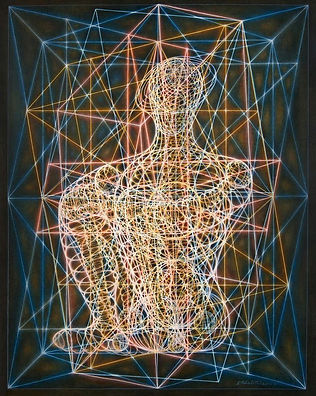
PAVEL
TCHELITCHEW
Pavel Tchelitchew was a Russian-born artist known for his Surrealist portraits and anatomical studies. Often camouflaging human bodies and faces into geometric lines or landscape forms, the artist used both abstraction and symbolism to convey both the outer and inner appearance of an object. “We are in the midst of the most appalling and impossible not to be seen horrors and madness,” he said of society.
His anatomical depictions of the skinless human body bear a strong resemblance to Alex Grey. But more abstract and less affirming of the transcendent oneness as pure, sentient energy in harmony with the universe. Tchelitchew just confronts me with the mysterious energies that make up this life but he doesn’t give me the answers.
In the mid-1920s, Tchelitchew limited his palette to earth tones and continually pared it down until it consisted only of grays and whites. He used heavy impasto and sometimes incorporated coffee grounds and house paint. As he began creating metamorphic compositions, in which a particular image would be created out of thematically relevant forms, Tchelitchew’s art became more closely associated with surrealism. However, while it shares surrealism’s unsettling quality reminiscent of a churning unconscious mind, Tchelitchew eschewed automatism as a technique. Instead, like the post-surrealists of the American West Coast, Tchelitchew chose his subject matter and composed his images with conscious deliberation.
In the late 1920s, multiple images increasingly became the focus of his art. In these works Tchelitchew sought to reveal both the organic substructure of an object as well as its place in space and time. Through a synthesis of these components, he intended to reveal “not just the illusion of an object as seen by the normal eye but the sum of inner knowledge as well.” In other words, memory and imagination form a visual field that an artist can reproduce just like he or she would an external, objective landscape, figure, or still life. As the 1930s progressed, Tchelitchew expanded his colour palette and complicated his use of space. By the mid-1930s, he was creating compositions based on triple perspective and foreshortening
In 1943, merging his interest in alchemy with “the anatomical illustrations of the sixteenth century Flemish anatomist and physician Andreas Vesalius,” Tchelitchew began his first “interior landscapes,” noted for their depiction of “the human body, with its veins and arteries, as transparent, in order to suggest the transcendence of the spirit over material substance.”As these figures evolved over the following years, he increasingly returned to the simplicity of his original wire basket idea so that his “overlapping forms would not seem clogged.” Use of clean spiral lines became increasingly pervasive, and by 1950 his images were composed completely of rhythmic spiralled lines with all volumes entirely transparent. Believing that these works approached the fourth dimension—that of time—Tchelitchew intended them to reveal a sense of unity through diversity and continuity in the face of change.


His method might be different form Jeff Muhs or Frédéric Fontenoy but the results are giving me the same feeling. It asked me to step back, observe and question my intentions in every stroke I put on the paper. Looking deep inside my body and analyse it in a calmer way. Carefully recording and observing the body more than I used too. The way he stripped of outer part of the figure is similar to the way I had used to diagnose the irregular feelings that form up inside of me. Peeling out layers and layers of myself and then drove my mind to focus on the abnormal part of the body. The vision gets darker while the feeling is getting more and more clear. The mind starting to visualise what is happening in the system. Without input from the eyes, every time the mind drift deeper inside of the body, the visual is more surreal. Each layer that has been peeled off also distorted the vision that can be seen through the mind. Internal environment getting bigger, the mind getting smaller. Creating a new kind of universe only to be experienced when I truly communicate with my body.






